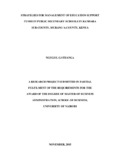| dc.description.abstract | Organizations are open systems which are structured to exploit available human and other resources. They are expected to post superior performance to satisfy their stakeholders. To achieve this, organizations require scanning of their environments in order to identify challenges and available opportunities. With this awareness, organizations devise strategies to address challenges to outwit competitors and exploit the opportunities available. Public secondary schools like other organizations are open systems which interact with environment. They are funded through the joint effort of the GOK, Development Partners, parents and other donors. (ESF)) disbursed and monies generated internally in the public secondary schools in Kandara Sub-county ought to be managed in a prudent way to provide infrastructure like classrooms, laboratories, ICT equipment, employ teachers, support staff, provide access to education and retain students in schools. It is through such efforts that quality education could be achieved in the Sub-county. The research conducted in this study, embraced the descriptive cross-sectional survey. A descriptive cross-sectional survey was appropriate for this kind of research because it captured the characteristics of public secondary schools which were similar. The study aimed at establishing its challenges in the management of ESF. Results obtained from the data collected, indicated that schools faced similar challenges. Among the most serious challenges unearthed by the research study included: late payment of fees by parents/untimely disbursement of grants by MOEST. Others included delayed project completion period, project escalation costs, debts by parents, use of ICT and sourcing of finances. In Kandara Sub-county schools also faced challenges in the management of ESF occasioned by employing a large number of BOM teachers and unethical practice. Expensive repair, maintenance and improvement costs and competence of Accounts staff were also cited as challenges. The salient findings on the strategies adopted by the schools included using funds for the intended purpose, financial reporting, budgeting, project monitoring and stakeholder involvement. However, the schools were poor at use of social networks and assessment of socio-political risks in the management of ESF. The research study brought out the need for the schools to devise policies to augment ESF, collect debts, and develop the capacity of staff. Regular environmental scanning including stakeholder analysis would be necessary. The research study was carried out in all the 52 public secondary school in Kandara Sub-county but only 71% of the schools responded. Like in other research studies, respondents’ bias could not be totally eliminated. The results of the study introduced other areas for further research such as investigation on why schools have poor socio-networks in a bid to reduce the cost of education to parents. Improvement of public secondary schools in Kandara Sub-county would require establishment of socio-networks with stakeholders to enhance ESF. Through such networks, Public Private Partnership and lobbying for resources would enable the public secondary schools to improve the infrastructure available and award bursaries to needy students. | en_US |

